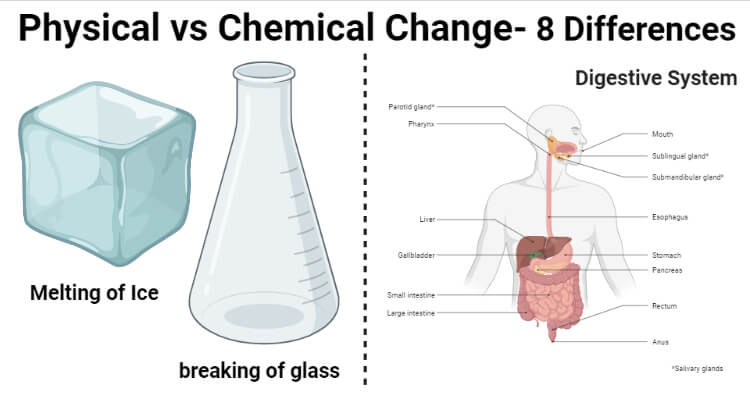Interesting Science Videos
Physical Change Definition
A physical change is a process that changes the physical form of a substance but not its chemical composition.
- During a physical change, the molecules of a substance are rearranged, but the chemical composition of the substance remains unchanged.
- A physical change usually involves a change in physical properties like the change of strength, change of state, shape, size, color, etc.
- Physical changes are reversible changes, but reversibility cannot be used as a criterion for classification as some changes can be irreversible.
- Physical changes involving changes in the shape, size, and state of molecules involve the rearrangement of atoms.
- Since the chemical composition of a substance is not changed as a result of physical change, no new substances are formed.
- The amount of energy absorbed or released during a physical change is significantly less as the changes tend to be temporary.
- Some examples of physical changes are melting of ice, breaking of glass, boiling water, etc.

Chemical Change Definition
A chemical change is a process that changes the chemical composition of a substance resulting in a new compound.
- Chemical change involves either chemical synthesis or chemical decomposition. Chemical synthesis results in the formation of a new substance from two or more chemical substances. Chemical decomposition involves the breakdown of a chemical substance into two or more different substances.
- Chemical changes are also called chemical reactions, most of which are irreversible, but some can be reversible.
- During a chemical change, the atoms of the substance are rearranged, and the change is accompanied by a change in energy. Chemical reactions can either be endothermic or exothermic, depending on if they absorb or release energy.
- Chemical changes can be categorized into three groups; inorganic changes, organic changes, and biochemical changes.
- Inorganic changes are the reactions between elements and compounds, usually occurring in laboratories or in large-scale industries.
- Organic chemical changes are reactions between organic compounds composed of carbon, hydrogen, and few other elements.
- Biochemical changes are the reactions occurring with living organisms during their growth and metabolism. Biochemical reactions are usually regulated by enzymes and hormones.
- Some examples of chemical changes are burning paper, digestion, electroplating, etc.
8 Key differences (Physical vs Chemical Change)
| Characteristics | Physical Change | Chemical Change |
| Definition | A physical change is a process that changes the physical form of a substance but not its chemical composition. | A chemical change is a process that changes the chemical composition of a substance resulting in a new compound. |
| Changes | Physical changes involve the changes in the arrangement of atoms. | Chemical changes involve changes in the chemical composition of the substance. |
| Energy | Physical changes absorb or release a comparatively less amount of energy. | Chemical changes are accompanied by the absorption or release of a significant amount of energy. |
| Original form | The original form of the substance can be regained by simple means in most of the physical changes. | The original form of the substance cannot be regained by simple physical means. |
| New substances | No new substance can be formed as a result of physical changes. | New substances can be formed as a result of chemical changes. |
| Reversibility | Physical changes are usually reversible. | Chemical changes are usually irreversible. |
| Composition | The chemical composition of a matter remains unchanged after a physical change. | The chemical composition of a matter changes after a chemical change. |
| Examples | Some examples of physical changes are melting of ice, breaking of glass, boiling water, etc. | Some examples of chemical changes are burning paper, digestion, electroplating, etc. |
Examples of Physical Change
Melting of Ice
- The melting of ice is an example of physical change as the shape and state of water change, but the chemical composition remains the same.
- The conversion of ice into water and water into ice can be done easily by the process of melting and freezing, respectively.
- It is a physical change as it is reversible and doesn’t change the chemical composition of the substance.
- Water molecules in ice are closer than those in water; thus, changes occur in the position of the molecules but not their number.
- The conversion of ice into water involves the absorption of energy in the form of heat energy.
Examples of Chemical Change
Digestion
- Digestion is the process of conversion of large macromolecules into smaller molecules in the presence of specific enzymes.
- It is a chemical change as the chemical composition of the substances changes as the larger molecule is broken down into smaller particles.
- The change is a biochemical change that occurs in almost all living organisms throughout the world. In higher organisms, the process occurs within a system where a number of organs work together to complete the process.
- In lower organisms, the process is less complex as these utilize comparatively less complex substances.
References and Sources
- Gautum SD, Pant M and Adhikari NR (2016). Comprehensive Chemistry, Part 2. Sixth Edition. Heritage Publishers and Distributors Pvt. Ltd
- https://byjus.com/chemistry/difference-between-physical-and-chemical-change/
- https://sciencetrends.com/10-chemical-change-examples/ – 16%
- https://en.m.wikipedia.org/wiki/Physical_change – 8%
- https://www.thoughtco.com/definition-of-physical-change-605910 – 7%
- https://tutors.com/lesson/chemical-change-definition-properties-examples – 3%
- https://quizizz.com/admin/quiz/5d7024989f07ce001bd403a8/bio-unit-1-quiz – 1%
- https://www.mysolutionguru.com/ps/physical-and-chemical-changes/252 – 1%
- https://www.mariaregina.org/ourpages/auto/2016/6/9/48988952/Final_Review_tc_2_.pdf – 1%
